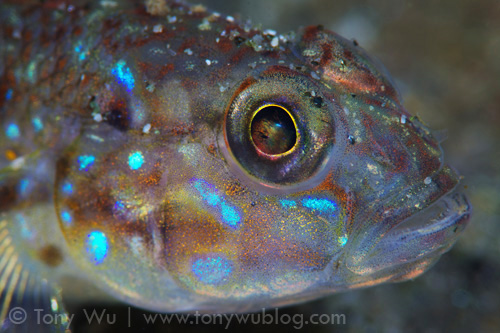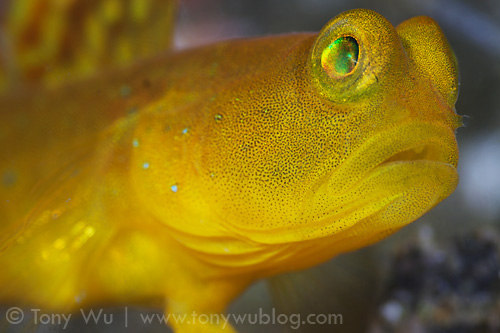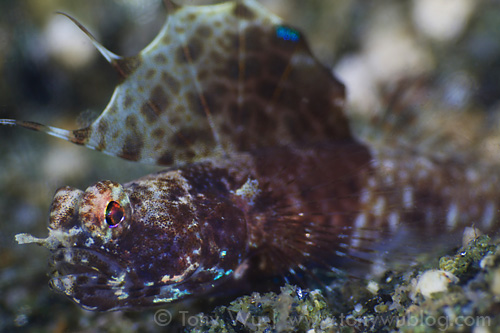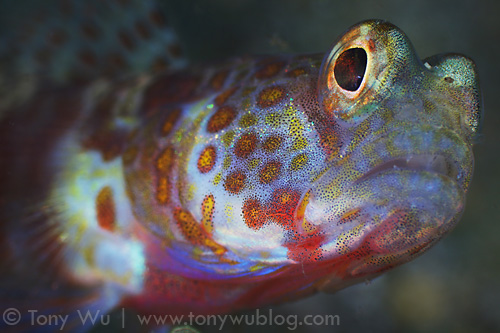For our final day of this second of three cruises aboard MV Golden Dawn in Papua New Guinea, we dived at a mucky area called Waga Waga, which is across the bay from Alotau.
From previous visits, I recalled that there was an interesting variety of gobies that made their home near the wreck, so I decided to go with a super macro set up.
Specifically, I used my Canon 100mm lens stacked with a Kenko 3x teleconverter; a Sola 600 focus light to help me find/ see my subjects; and two Inon S-2000 strobes to keep my rig as light as possible.

Close-up of a Vanderhorstia sp. goby at Waga Waga in Milne Bay
Using a focus light helps a lot, as you’ll need to achieve critical focus on the eye, which is sort of like being Luke shooting a missile down that ridiculously small hole in the Death Star. It takes a bit of luck, a lot of concentration, and plenty of muttering under your breath.
For this purpose, the Sola 600 is a perfect size to sit on top of my camera. I really like using the red light function, which imparts some colour contrast for a smidgeon of extra help discerning lines and edges. (Disclosure: Sola 600 provided by Scubacam and Light and Motion). I chose Inon S-2000 lights because they’re compact and light, while providing plenty of light for macro photography.
If you try taking photographs like this with a DSLR, you’ll need to use manual focus, as teleconverters reduce incoming light levels in a big way. In this instance, murky water and overcast skies made focusing even more of a challenge.

I think this is a Cryptocentrus cinctus shrimp goby
Gobies are generally skittish fish. You would probably be on-edge be as well if you were subject to the constant possibility of being made into a mid-morning snack by a larger animal.
But...it’s actually not too difficult to approach gobies if you keep a few things in mind.
First, descending from above rarely works. You should get low to the ground, preferably lying on the sand or rubble. Obviously, you should make sure you don’t crush anything in doing so, but fortunately, shrimp gobies often make their homes in places where nothing else lives.
Second, control your breathing so that you don’t spew bubbles all at once. If you exhale in a sudden manner, you create a series of explosive sound waves that smack the fish in a manner similar to the shocking sensation you’d experience if a squadron of supersonic jets buzzed you at close quarters while doing Mach 5.

Rayed shrimp goby (Tomiyamichthys sp.) in almost the exact
same place I found one five and a half years ago
Get your camera and strobe settings right before you approach. To do this, try aiming at a rock or some other inanimate object of similar size and colour to get everything just right while you’re still some distance from the goby in question.
When you approach, do so slowly, centimetre by centimetre. As you crawl toward the fish, you can be sure that the goby is watching you, so be considerate. Stop and return the favour from time to time. Sit and watch for a while without moving, so the fish has time to adjust to your presence.
In many cases, gobies will get nervous and dart back into their burrows in spite of your best efforts to mimic an innocuous rock, but every once in a while, you’ll get a cooperative fish, and you’ll soon find yourself within reasonable shooting distance.

Amblyeleotris sp. shrimp goby giving me attitude
Finally, it pays to study fish body-language and behaviour. Shrimp gobies, for instance, twitch their tails when they’re nervous. They do this to warn their blind-shrimp companions of possible danger. So if you sense twitchiness, freeze and make like a boring coral head until the fish gives the shrimp the all-clear sign.
Note: My goby IDs are tentative. If you spot a mistake, please let me know.